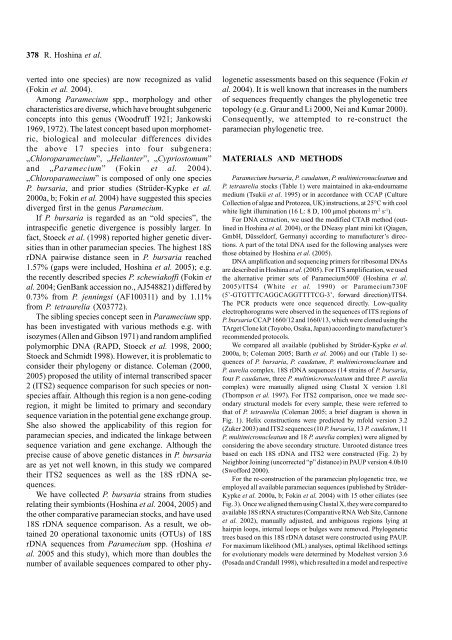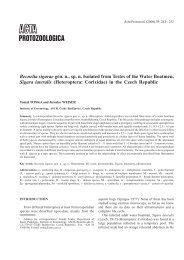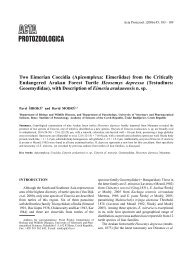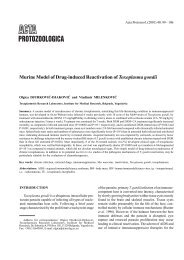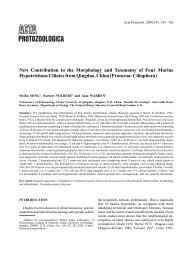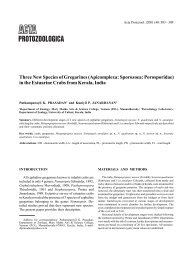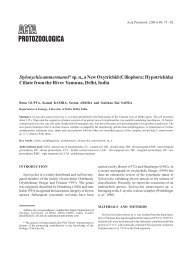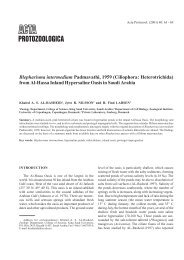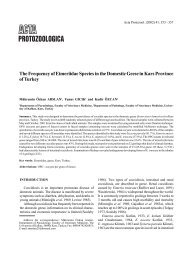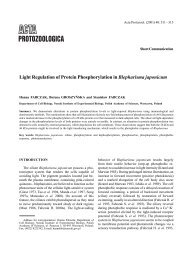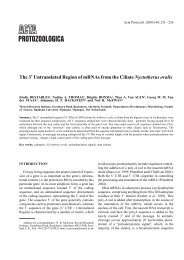Intraspecific Genetic Divergence of Paramecium ... - CiteSeerX
Intraspecific Genetic Divergence of Paramecium ... - CiteSeerX
Intraspecific Genetic Divergence of Paramecium ... - CiteSeerX
You also want an ePaper? Increase the reach of your titles
YUMPU automatically turns print PDFs into web optimized ePapers that Google loves.
378 R. Hoshina et al.<br />
verted into one species) are now recognized as valid<br />
(Fokin et al. 2004).<br />
Among <strong>Paramecium</strong> spp., morphology and other<br />
characteristics are diverse, which have brought subgeneric<br />
concepts into this genus (Woodruff 1921; Jankowski<br />
1969, 1972). The latest concept based upon morphometric,<br />
biological and molecular differences divides<br />
the above 17 species into four subgenera:<br />
„Chloroparamecium”, „Helianter”, „Cypriostomum”<br />
and „<strong>Paramecium</strong>” (Fokin et al. 2004).<br />
„Chloroparamecium” is composed <strong>of</strong> only one species<br />
P. bursaria, and prior studies (Strüder-Kypke et al.<br />
2000a, b; Fokin et al. 2004) have suggested this species<br />
diverged first in the genus <strong>Paramecium</strong>.<br />
If P. bursaria is regarded as an “old species”, the<br />
intraspecific genetic divergence is possibly larger. In<br />
fact, Stoeck et al. (1998) reported higher genetic diversities<br />
than in other paramecian species. The highest 18S<br />
rDNA pairwise distance seen in P. bursaria reached<br />
1.57% (gaps were included, Hoshina et al. 2005); e.g.<br />
the recently described species P. schewiak<strong>of</strong>fi (Fokin et<br />
al. 2004; GenBank accession no., AJ548821) differed by<br />
0.73% from P. jenningsi (AF100311) and by 1.11%<br />
from P. tetraurelia (X03772).<br />
The sibling species concept seen in <strong>Paramecium</strong> spp.<br />
has been investigated with various methods e.g. with<br />
isozymes (Allen and Gibson 1971) and random amplified<br />
polymorphic DNA (RAPD, Stoeck et al. 1998, 2000;<br />
Stoeck and Schmidt 1998). However, it is problematic to<br />
consider their phylogeny or distance. Coleman (2000,<br />
2005) proposed the utility <strong>of</strong> internal transcribed spacer<br />
2 (ITS2) sequence comparison for such species or nonspecies<br />
affair. Although this region is a non gene-coding<br />
region, it might be limited to primary and secondary<br />
sequence variation in the potential gene exchange group.<br />
She also showed the applicability <strong>of</strong> this region for<br />
paramecian species, and indicated the linkage between<br />
sequence variation and gene exchange. Although the<br />
precise cause <strong>of</strong> above genetic distances in P. bursaria<br />
are as yet not well known, in this study we compared<br />
their ITS2 sequences as well as the 18S rDNA sequences.<br />
We have collected P. bursaria strains from studies<br />
relating their symbionts (Hoshina et al. 2004, 2005) and<br />
the other comparative paramecian stocks, and have used<br />
18S rDNA sequence comparison. As a result, we obtained<br />
20 operational taxonomic units (OTUs) <strong>of</strong> 18S<br />
rDNA sequences from <strong>Paramecium</strong> spp. (Hoshina et<br />
al. 2005 and this study), which more than doubles the<br />
number <strong>of</strong> available sequences compared to other phylogenetic<br />
assessments based on this sequence (Fokin et<br />
al. 2004). It is well known that increases in the numbers<br />
<strong>of</strong> sequences frequently changes the phylogenetic tree<br />
topology (e.g. Graur and Li 2000, Nei and Kumar 2000).<br />
Consequently, we attempted to re-construct the<br />
paramecian phylogenetic tree.<br />
MATERIALS AND METHODS<br />
<strong>Paramecium</strong> bursaria, P. caudatum, P. multimicronucleatum and<br />
P. tetraurelia stocks (Table 1) were maintained in aka-endoumame<br />
medium (Tsukii et al. 1995) or in accordance with CCAP (Culture<br />
Collection <strong>of</strong> algae and Protozoa, UK) instructions, at 25°C with cool<br />
white light illumination (16 L: 8 D, 100 µmol photons m -2 s -1 ).<br />
For DNA extraction, we used the modified CTAB method (outlined<br />
in Hoshina et al. 2004), or the DNeasy plant mini kit (Qiagen,<br />
GmbH, Düsseldorf, Germany) according to manufacturer’s directions.<br />
A part <strong>of</strong> the total DNA used for the following analyses were<br />
those obtained by Hoshina et al. (2005).<br />
DNA amplification and sequencing primers for ribosomal DNAs<br />
are described in Hoshina et al. (2005). For ITS amplification, we used<br />
the alternative primer sets <strong>of</strong> <strong>Paramecium</strong>500F (Hoshina et al.<br />
2005)/ITS4 (White et al. 1990) or <strong>Paramecium</strong>730F<br />
(5’-GTGTTTCAGGCAGGTTTTCG-3’, forward direction)/ITS4.<br />
The PCR products were once sequenced directly. Low-quality<br />
electrophorograms were observed in the sequences <strong>of</strong> ITS regions <strong>of</strong><br />
P. bursaria CCAP 1660/12 and 1660/13, which were cloned using the<br />
TArget Clone kit (Toyobo, Osaka, Japan) according to manufacturer’s<br />
recommended protocols.<br />
We compared all available (published by Strüder-Kypke et al.<br />
2000a, b; Coleman 2005; Barth et al. 2006) and our (Table 1) sequences<br />
<strong>of</strong> P. bursaria, P. caudatum, P. multimicronucleatum and<br />
P. aurelia complex. 18S rDNA sequences (14 strains <strong>of</strong> P. bursaria,<br />
four P. caudatum, three P. multimicronucleatum and three P. aurelia<br />
complex) were manually aligned using Clustal X version 1.81<br />
(Thompson et al. 1997). For ITS2 comparison, once we made secondary<br />
structural models for every sample, these were referred to<br />
that <strong>of</strong> P. tetraurelia (Coleman 2005; a brief diagram is shown in<br />
Fig. 1). Helix constructions were predicted by mfold version 3.2<br />
(Zuker 2003) and ITS2 sequences (10 P. bursaria, 13 P. caudatum, 11<br />
P. multimicronucleatum and 18 P. aurelia complex) were aligned by<br />
considering the above secondary structure. Unrooted distance trees<br />
based on each 18S rDNA and ITS2 were constructed (Fig. 2) by<br />
Neighbor Joining (uncorrected “p” distance) in PAUP version 4.0b10<br />
(Sw<strong>of</strong>ford 2000).<br />
For the re-construction <strong>of</strong> the paramecian phylogenetic tree, we<br />
employed all available paramecian sequences (published by Strüder-<br />
Kypke et al. 2000a, b; Fokin et al. 2004) with 15 other ciliates (see<br />
Fig. 3). Once we aligned them using Clustal X, they were compared to<br />
available 18S rRNA structures (Comparative RNA Web Site, Cannone<br />
et al. 2002), manually adjusted, and ambiguous regions lying at<br />
hairpin loops, internal loops or bulges were removed. Phylogenetic<br />
trees based on this 18S rDNA dataset were constructed using PAUP.<br />
For maximum likelihood (ML) analyses, optimal likelihood settings<br />
for evolutionary models were determined by Modeltest version 3.6<br />
(Posada and Crandall 1998), which resulted in a model and respective


